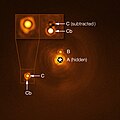File:New planetary-mass object found in quadruple system (potw2338a).jpg
Page contents not supported in other languages.

Size of this preview: 600 × 600 pixels. Other resolutions: 240 × 240 pixels | 480 × 480 pixels | 768 × 768 pixels | 1,024 × 1,024 pixels | 1,616 × 1,616 pixels.
Original file (1,616 × 1,616 pixels, file size: 499 KB, MIME type: image/jpeg)
| This is a file from the Wikimedia Commons. Information from its description page there is shown below. Commons is a freely licensed media file repository. You can help. |
Summary
| DescriptionNew planetary-mass object found in quadruple system (potw2338a).jpg |
English: This Picture of the Week shows the unique stellar system HIP 81208, as captured by ESO’s Very Large Telescope (VLT) in Chile. Astronomers thought HIP 81208 was a system consisting of a massive central star (A, the central bright spot), a brown dwarf (B) circling around it, and a low-mass star (C) orbiting further away. However, a new study has revealed a never-before-seen hidden gem: an object (Cb), approximately 15 times more massive than Jupiter, orbiting around the smaller of the two stars (C).The discovery of Cb means that HIP 81208 is a uniquely intriguing system with two stars and two smaller bodies orbiting each one –– in other words, a hierarchical quadruple system. The mass of the newly found Cb object places it right at the border between planets and brown dwarfs –– failed stars that are not massive and hot enough to fuse hydrogen into helium.The hidden giant Cb was spotted when a team of astronomers, led by A. Chomez of the Paris Observatory, re-analysed archival data from the Spectro-Polarimetric High-contrast Exoplanet REsearch (SPHERE) instrument installed on the VLT. While many other instruments use indirect methods to hunt for far-flung worlds, SPHERE uses a technique known as direct imaging: what we see here is an actual image of the system. Indeed, this is the first hierarchical quadruple system to be found using direct imaging, which will prove invaluable to understanding how complex systems like this one form and evolve. |
||
| Date | 18 September 2023 (upload date) | ||
| Source |
|
||
| Author | ESO/A. Chomez et al. | ||
| Other versions |
|
Licensing
 |
This media was created by the European Southern Observatory (ESO).
Their website states: "Unless specifically noted, the images, videos, and music distributed on the public ESO website, along with the texts of press releases, announcements, pictures of the week, blog posts and captions, are licensed under a Creative Commons Attribution 4.0 International License, and may on a non-exclusive basis be reproduced without fee provided the credit is clear and visible." To the uploader: You must provide a link (URL) to the original file and the authorship information if available. |
This file is licensed under the Creative Commons Attribution 4.0 International license.
| |
Captions
This Picture of the Week shows the unique stellar system HIP 81208, as captured by ESO’s Very Large Telescope (VLT) in Chile.
image/jpeg
1,616 pixel
1,616 pixel
510,541 byte
fd01133f018ee5199834f1544dbeab0c893a6e53
18 September 2023
p82oyy5civ5dx78ui2ysn3jx1qqfxbgq18xy03x1obkaqh4ir
File history
Click on a date/time to view the file as it appeared at that time.
| Date/Time | Thumbnail | Dimensions | User | Comment | |
|---|---|---|---|---|---|
| current | 07:15, 18 September 2023 |  | 1,616 × 1,616 (499 KB) | OptimusPrimeBot | #Spacemedia - Upload of https://www.eso.org/public/archives/images/large/potw2338a.jpg via Commons:Spacemedia |
File usage
The following pages on the English Wikipedia use this file (pages on other projects are not listed):
Metadata
This file contains additional information, probably added from the digital camera or scanner used to create or digitize it.
If the file has been modified from its original state, some details may not fully reflect the modified file.
| Credit/Provider | ESO/A. Chomez et al. |
|---|---|
| Source | European Southern Observatory |
| Short title |
|
| Image title |
|
| Usage terms |
|
| Date and time of data generation | 06:00, 18 September 2023 |
| Software used | Adobe Photoshop 24.7 (Windows) |
| File change date and time | 16:52, 7 September 2023 |
| Date and time of digitizing | 14:55, 14 August 2023 |
| Date metadata was last modified | 18:52, 7 September 2023 |
| Unique ID of original document | xmp.did:073ac137-ab06-b44d-9802-1708131050c5 |
| Keywords | HIP 81208 |
| Contact information |
Karl-Schwarzschild-Strasse 2 Garching bei München, None, D-85748 Germany |
| IIM version | 4 |

